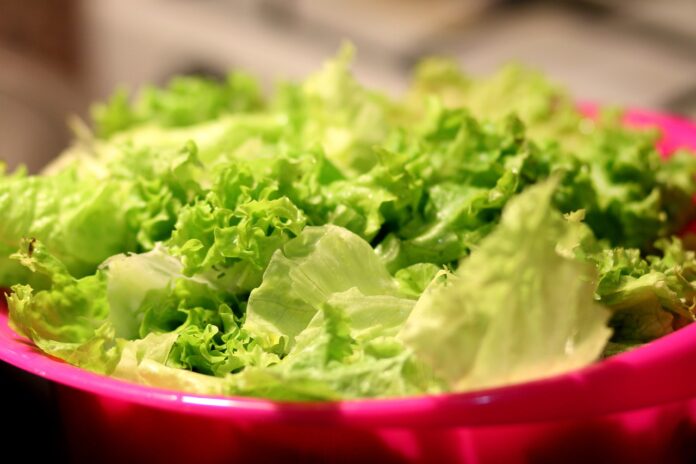Lettuce (Lactuca sativa) is a leafy vegetable belonging to the daisy family (Asteraceae). It is one of the most widely cultivated and consumed vegetables globally, prized for its versatility and mild flavor. Native to the Mediterranean region, lettuce has been cultivated since ancient times, with evidence of its use in Ancient Egypt and Rome.
Lettuce varieties are categorized into four main types:
- Crisphead (Iceberg): Known for its tight, spherical heads and crisp texture.
- Romaine (Cos): Distinguished by its elongated, sturdy leaves and central ribs.
- Leaf Lettuce: Features loosely arranged leaves, often red or green.
- Butterhead (Boston and Bibb): Recognized for soft, tender leaves that form loose heads.
Interesting Facts About Lettuce:
- Ancient Origins: Lettuce was first cultivated by the Egyptians over 6,000 years ago, primarily for its seeds used in oil production
- Roman Contribution: The Romans popularized lettuce as a vegetable, believing it had medicinal properties
- Hydration Hero: Iceberg lettuce has one of the highest water contents among vegetables, consisting of about 96% water
- Multiple Varieties: There are several types of lettuce, including romaine, butterhead, leaf, and crisphead, each with unique flavors and textures
- Romaine’s Sleep Secret: Romaine lettuce contains lactucin, which has mild sedative properties and can promote relaxation
- World’s Largest Lettuce Salad: The largest lettuce salad ever made weighed over 20,000 pounds, achieved in Russia in 2016
- Space Lettuce: Lettuce was the first vegetable grown and eaten in space by astronauts aboard the International Space Station in 2015
- Low-Calorie Food: Lettuce is a dieter’s favorite, as a single cup contains less than 10 calories
- Rich in Folate: Romaine lettuce is a good source of folate, a B-vitamin essential for cell growth and function
- Lettuce in Pregnancy: Dark leafy varieties like romaine and spinach are highly recommended for pregnant women due to their nutrient density
- America’s Favorite Salad Green: Lettuce has been a staple in American salads since the late 19th century, thanks to improved refrigeration for shipping
- First Name Roots: The word “lettuce” derives from the Latin lactuca, referring to the white sap found in its stems
- Symbol of Fertility: In ancient Egypt, lettuce symbolized fertility and was associated with the god Min
- Canine-Friendly Snack: Lettuce, especially romaine and iceberg, is safe for dogs and serves as a low-calorie treat
- Largest Producer: China is the world’s leading producer of lettuce, contributing nearly half of the global supply
- Hydroponic Lettuce: Hydroponics allows lettuce to grow without soil, requiring significantly less water than traditional farming
- Lettuce and the Titanic: Iceberg lettuce gained popularity in the early 20th century, coinciding with the Titanic era
- Seasonal Crops: While lettuce can be grown year-round, its peak seasons are spring and fall due to its preference for cooler temperatures
- Romaine’s Boom: Romaine’s popularity in the U.S. soared with the Caesar salad, leading to a fivefold increase in cultivation since the 1970s
- Natural Sunscreen: Lettuce leaves contain carotenoids, which help protect plants (and us) from UV radiation
- Vertical Farming Marvel: Lettuce is a key crop for vertical farms, using up to 90% less water than traditional methods
- Cultural Symbolism: In Korea, lettuce wraps (ssam) are a popular way to eat grilled meat, emphasizing communal dining
- Nutritional Differences: Dark green lettuces like romaine have significantly more nutrients compared to pale varieties like iceberg
- Living Lettuce: Some supermarkets sell lettuce with roots still attached to maintain freshness longer
- Elizabethan Hair Secrets: In the Elizabethan era, lettuce was rumored to have been used in hair tonics
- Lettuce in Literature: It has appeared in historical texts and recipes, showcasing its longevity as a favored food
- First Domesticated Plant?: Some historians argue that lettuce could be among the first plants intentionally bred for food
- No Herb Here: Despite its culinary use, lettuce is botanically classified as a vegetable, not an herb
- Purple Lettuce: Radicchio, often mistaken as a lettuce, is a purple chicory that adds color to salads
- Eco-Friendly Packaging: Some lettuce growers now use biodegradable wraps to reduce plastic waste
